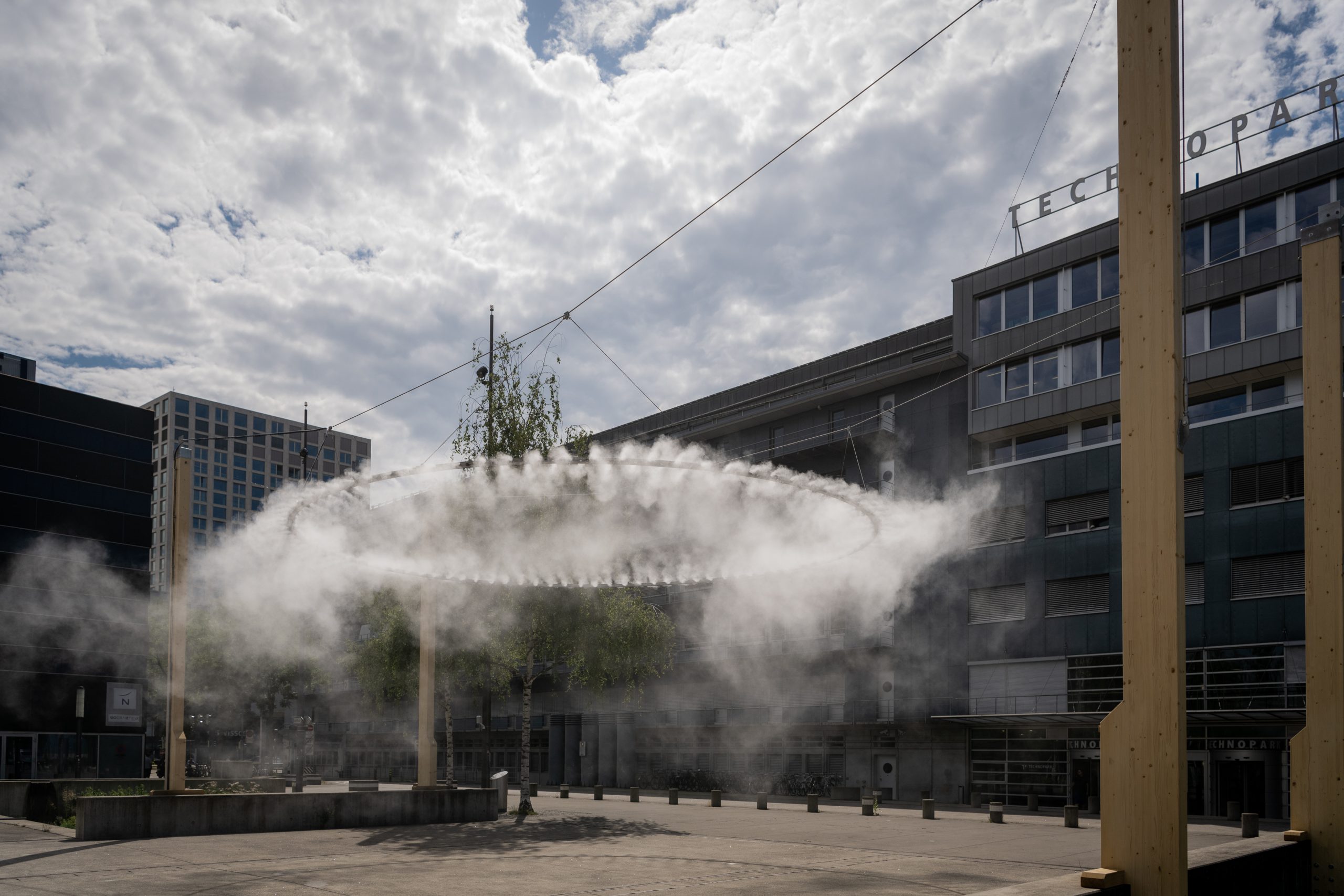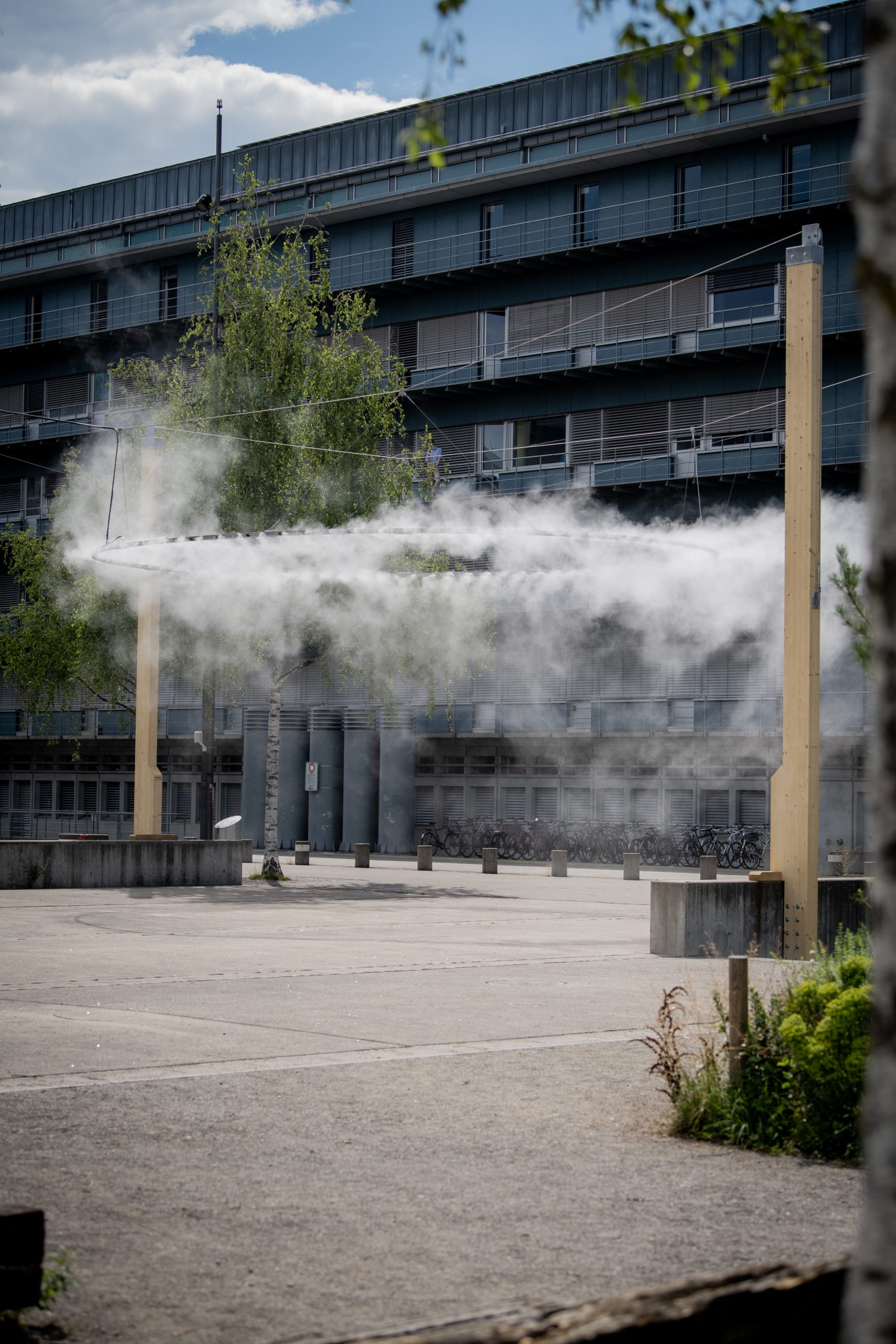Alto Zürrus, a cloud of fog above Turbinenplatz

In a pilot project in Zurich, a cloud of fog is trying to cool down urban space. 180 nozzles spray water over the heads of passers-by.
Billboard
Skyscrapper
Halfpage
A cloud of fog is supposed to cool the urban space above Turbinenplatz in Zurich. The first impression: it does little. Read more about the pilot project here.
A cloud called “Alto Zürrus”
Zurich’s Turbinenplatz in the west of the city is regularly up to 6 degrees warmer than the surrounding area. To regulate the effect of the urban heat island, the city has now launched a pilot project: An artificial cloud of fog turns on at 30 degrees and is supposed to have a cooling effect. Up to 10 degrees less should be possible due to the evaporating water particles, which extract heat from the ambient air.
Anyone standing directly under or downwind of this artificial cloud will feel a slight cooling effect. Cooling water sprays from 180 nozzles over the heads of passers-by. To activate, the sensors of the ring-shaped installation must detect an air temperature of at least 30 degrees. There are also humidity sensors. If these detect an impending rainfall, the cloud called “Alto Zürrus” does not activate.
The artificially generated fog cloud comes from an aluminium ring with fog nozzles that hangs from four wooden poles about five metres above the turbine site. The nozzles atomise the water so finely that the air around the cloud cools down. This should allow people nearby to enjoy the cooler air without getting wet. “Alto Zürrus” will operate on up to 44 dry, hot days per year.
Criticism of the cloud at Turbinenplatz
Zurich’s new cloud has already attracted many interested parties. However, it quickly became apparent that the hoped-for effect is only minimal. People standing directly under the aluminium ring report a slight cooling effect. However, this is hardly noticeable in the surrounding area and in other corners of Turbinenplatz. The cooling spray does not reach the ground and the ambient air does not have a noticeably lower temperature.
The water consumption of “Alto Zürrus” is also a point of criticism – especially in view of the droughts in Europe. This is because it consumes drinking water and energy. The cloud sprays up to 100,000 litres of drinking water per year. That is 7.5 litres per minute with the energy consumption of a hoover.
The pilot project started in July 2022 and will run until autumn 2024. It is part of the city’s heat mitigation planning. This aims to cool down the city during hot summer months. The funding comes from a Smart City Innovation Loan.
An employee of Grün Stadt Zürich had the idea for “Alto Zürrus”. He prevailed in an internal city competition. According to Grün Stadt Zürich, the project costs are 140,000 Swiss francs. This also includes the costs for the scientific monitoring of the effect. The effect of the cloud will be precisely measured and documented.

Comparisons with “Le Nuage” in Yverdon 2002
Observers such as the Neue Züricher Zeitung (NZZ) compared the artificial cloud on Turbinenplatz with “Le Nuage”. This walkable cloud at Expo 2002 in Yverdon was considerably larger. It consisted of a steel construction in Lake Neuchâtel with a height of 20 metres and 31,400 stainless steel nozzles.
The NZZ wrote at the time: “Anyone strolling through the mounds of the Arteplage in Yverdon-les-Bains is reminded of prehistoric tumuli and dolmens. If you come to the lake from this direction in damp weather, you can see a small island rising out of the mist in front of you. From this perspective, the cloud looks like the mystical Avalon. Two fibreglass footbridges lead into it.”
In the “Alto Zürrus” cloud, it is not possible to walk through a cloud as in the mystical Avalon. However, the pilot project on Turbinenplatz is not art, but a means to an end.
The urban heat island Turbinenplatz
As early as 2021, the city of Zurich planted additional trees on Turbinenplatz in the Escher-Wyss area. This is one of the largest squares in the city. Since it is mainly covered with concrete, it gets oppressively hot here in midsummer. However, these trees need time to grow. Also, the site conditions at Turbinenplatz are not ideal: the trees will not be able to spread significantly or develop a large crown. At the same time, however, trees are the most effective means of combating the heat because of their cooling effect through evaporation as well as shade.
According to Zurich city councillor and head of civil engineering Simone Brander, cities must be expected to overheat more and more because of climate change. The number of hot days could double to 44 per year by 2040. According to Brander, cities like Zurich have the potential to support heat mitigation at the local level. Here, according to the city councillor, the cloud is an immediate measure, while trees and land unsealing have a medium-term effect. Overall, a combination of different means is needed.
Other cities, for example Vienna, are also experimenting with heat mitigation measures in the form of artificial clouds. How effective “Alto Zürrus” is will become clear in 2024, with the evaluation of the data.
Another approach for tackling urban heat islands is roof greening. Read more about this solution here: roof greening












